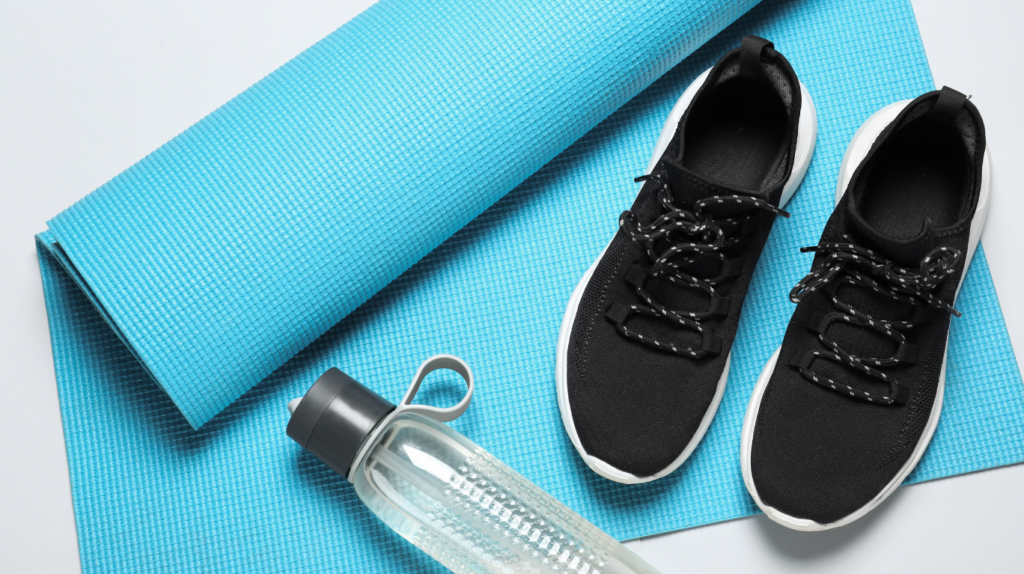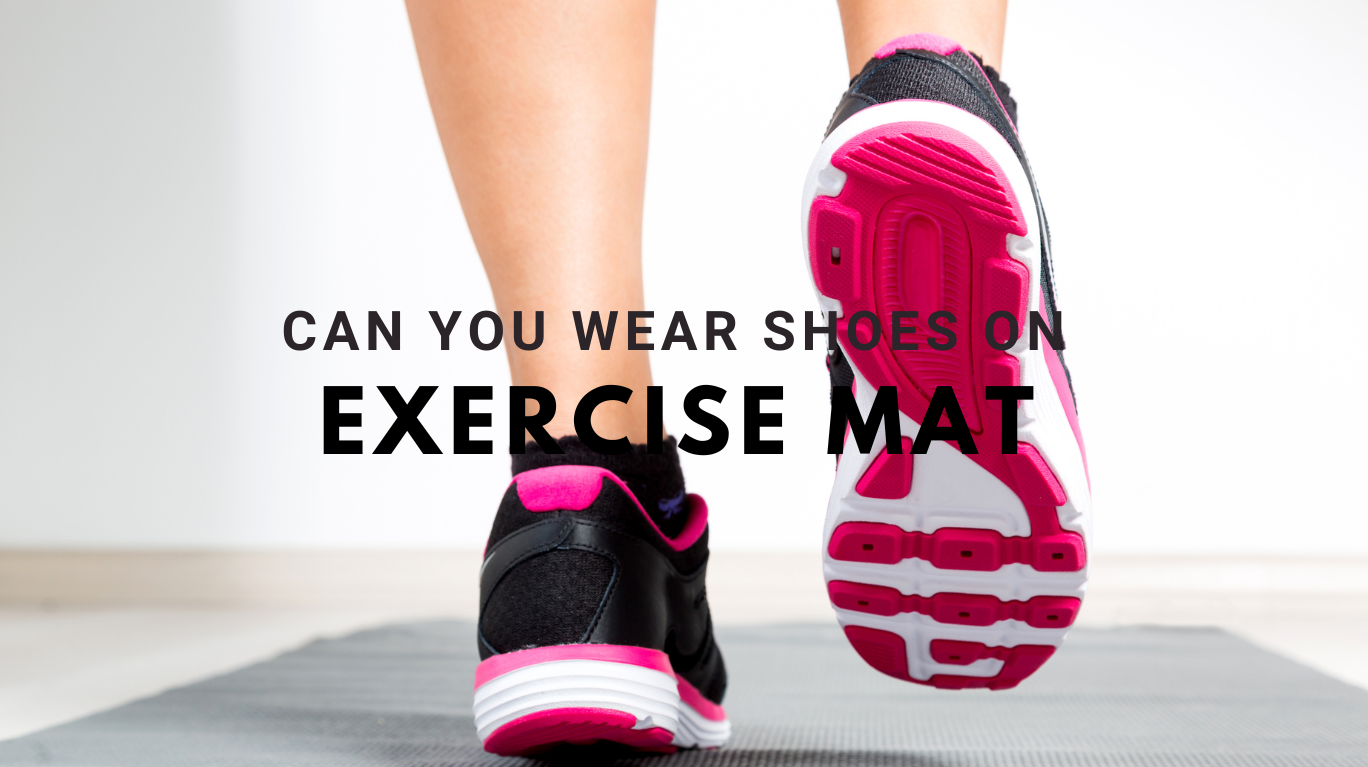Ever found yourself pondering the question, “Can you wear shoes on an exercise mat?” Many fitness enthusiasts are divided on this topic, causing flashing doubts during every workout. The cry of confusion is real – to wear shoes or not on your multi-function, shiny mat?
This question of wearing shoes on an exercise mat keeps coming up and has stirred up a debate in the fitness world. Some people are afraid that their shoes will ruin their mat or make it unclean. Others are afraid that their feet will be too hot or slippery without shoes.
But don’t stress! There is an easy answer to this old problem that will help you work out better and cleaner. Let’s delve deep into exploring a solution that quells this workout dilemma once and for all!
Benefits and Drawbacks of Wearing Shoes on an Exercise Mat
Just like any other decision we make, the choice to wear shoes on an exercise mat comes with its merits and demerits. Understanding these factors could help you determine the most suitable choice, depending on your individual circumstances.
The Benefits of Wearing Shoes on an Exercise Mat
Here are a few reasons why wearing shoes while exercising on a mat can be beneficial:
- Shoes provide support and stability to your feet and ankles. It can also help you maintain proper alignment and posture during dynamic exercises. Shoes can offer more grip and traction than bare feet or socks, especially on slippery or uneven surfaces. This can prevent you from slipping or sliding during your workout,
- They offer an enhanced grip and traction, especially during high-intensity workouts. This can prevent mishaps caused by slipping or sliding.
- Shoes, known as foot soldiers, protect you from possible injuries and ensure your workout remains a pain-free affair.
- If you have any foot problems or sensitivities, such as blisters, corns, calluses, or bunions, shoes give you comfort and cushioning. They also keep your feet warm and cozy during cold weather, letting you concentrate on your exercise.
- From a hygiene perspective, shoes preserve your exercise mat’s cleanliness by serving as a barrier against sweat and possible foot infections.
The Drawbacks of Wearing Shoes on an Exercise Mat
However, every coin has two sides. Just as there are benefits to wearing shoes during workouts, there are possible drawbacks. Here are those:
- The constant friction caused by shoes can result in wear and tear on your exercise mat over time.
- They could also leave dirt and stains, sacrificing the cleanliness of your mat.
- Sometimes the shoes might produce squeaky noises, which can be annoying and distracting.
Tips for Safely Wearing Shoes on an Exercise Mat
Now, if you’re leaning towards the shoes on exercise mat camp, here are some valuable tips to ensure a safe and effective workout.
1. Choosing the Right Shoes for Exercising on Mats
An essential factor in wearing shoes on an exercise mat is choosing the right pair. Certain characteristics are desirable for optimal results, such as:
- Opt for shoes with non-marking soles to prevent your exercise mat from getting marks or scuffs.
- Ensure they fit properly to prevent discomfort or injury while exercising.
- Additionally, go for shoes that are lightweight and flexible enough to allow natural foot movements.
- And, maintain shoe cleanliness, for the sake of your mat and overall hygiene.
2. Preparing Your Exercise Mat for Shoe Use
Proper exercise mat maintenance is a prerequisite to its durability. Routine cleaning might be necessary if you choose to wear shoes. To ensure additional protection, consider using a mat cover or overlay to cover the surface of the mat before using it with shoes. This can prevent any direct contact between the shoes and the mat, which reduces the risk of damage.
3. Minimizing the Impact of Wearing Shoes
Controlled movements are a strategy to reduce the impact shoes have on your mat. Avoiding excessive pressure on the mat not only benefits your mat but also prevents exercise injuries.
Alternatives to Wearing Shoes on an Exercise Mat
If the concept of wearing shoes during workouts doesn’t sit well with you, the following exercise mat footwear alternatives could be adopted:
Barefoot
Going barefoot is the simplest and most natural option for using an exercise mat. It allows you to feel the mat and the floor beneath you, which can enhance your balance and stability. It also allows your feet to breathe and move freely, which can improve your blood circulation and foot health. However, going barefoot may not be comfortable or safe for everyone, especially if you have any foot problems or injuries, or if the mat is dirty or cold.
Socks
Wearing socks is another option for using an exercise mat. Socks can provide some warmth and comfort for your feet, as well as some protection from any dirt or germs on the mat. However, socks may not provide enough support or grip for your feet on slippery surfaces.
Mat-Friendly Footwear
There are some types of footwear that are designed specifically for use on an exercise mat. These types of footwear can offer some of the benefits of both shoes and bare feet, without causing too much damage or noise on the mat. These include:
- Yoga Socks: Yoga socks have grips or rubber dots on the bottom to prevent slipping.
- Minimalist Shoes: Minimalist shoes have thin and flexible soles that mimic barefoot sensations.
How to Choose the Right Shoes for Your Workout

While this may sound obvious, the right shoes can make or break a workout session. Picking your exercise shoes depends greatly on the type of exercise, the make of your mat, the size and shape of your feet, and your comfort level. Let’s discuss these factors in detail:
1. Type of Exercise
Understanding the type of exercise is paramount to choosing the right shoes. For example, yoga and Pilates require shoes that allow natural foot movements and balance; and cardio and strength training require shoes that provide stability and shock absorption.
2. Exercise Mat Material and Thickness
Your mat material and thickness also guide your shoe choice, as different shoes are well-suited for rubber, foam, or cork mats.
3. Size and Shape of Your Feet
The size and shape of your feet also matter in choosing the right shoes for your workout. For example, wide feet may need shoes that have more room in the toe box; narrow feet may need shoes that have more snugness in the heel; and flat feet may need shoes that have more arch support.
4. Personal Preference
Ultimately, the best shoes for your workout are the ones that you feel comfortable and confident in. You should choose shoes that match your style, personality, and goals. Moreover, go for shoes that do not cause any pain, discomfort, or irritation to your feet during or after your workout.
Conclusion
Wearing shoes on an exercise mat can have both benefits and drawbacks, depending on the type of shoes, exercise, mat, and your personal preference. You should weigh the pros and cons of wearing shoes on an exercise mat, and follow the tips we’ve discussed in the article to ensure a safe and effective workout. By doing so, you can enjoy your exercise mat and your shoes to the fullest.
Common Queries
Is it advisable to exercise with shoes on a mat?
Deciding whether to exercise with shoes on a mat depends on various factors such as the type of exercise and mat, your shoe type, and comfort preferences. Both options have benefits and drawbacks.
How do shoes enhance your home workout experience?
Shoes can enhance your home workout experience by providing good grip, ankle support, foot comfort, and a protective barrier against possible injuries.
Can you do yoga with shoes on a mat?
Performing yoga with shoes on a mat can be difficult due to the flexibility and foot positioning required. Generally, it’s recommended to practice yoga barefoot or with specialized yoga footwear.
Is it appropriate to work out without socks?
If you’re comfortable and hygienic, working out without socks is appropriate. Socks can give your feet extra padding, warmth, and protection, but they can also make you slide or sweat out.
How do socks and shoes compare in terms of workout benefits and risks?
Socks and shoes both offer distinct benefits and risks in workouts. Shoes provide superior foot support, protection, and grip, but can cause wear and tear on the mat. On the other hand, socks offer minimal support and less friction causing wear, but may reduce grip and could lead to slipping.

